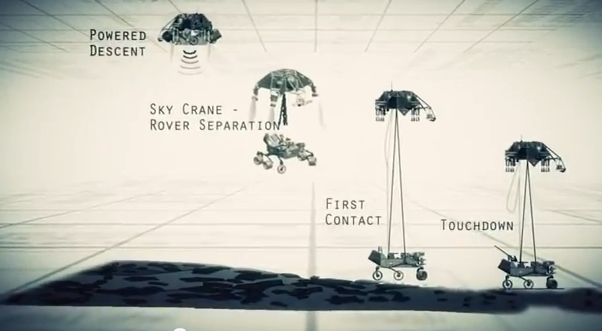
Building a state-of-the-art drone and getting it to Mars is hard enough, but the nail biting isn’t over when it arrives. Landing the $2.5 billion rover in one piece is a beast of a task in its own right. With NASA’s seventh Mars rover, Curiosity, landing on the Red Planet on August 6, the agency has released “7 Minutes of Terror,” a dramatic video, as a layman’s lesson in the engineering complexities of the strenuous seven-minute landing.
Curiosity was dispatched with the sole purpose of uncovering whether life once existed or possibly exists on Mars. Unlike its predecessors, Spirit and Opportunity, Curiosity won’t be dropping onto the planet in a bubble suit, bouncing along the Martian surface until rest. This time the landing process uses jet propulsion technology, enabling the rover’s vessel to hover and lower Curiosity onto the rocky terrain below using specially designed ropes.
The seven minutes of terror, or as NASA scientists call this timeframe, Entry, Descent, Landing (EDL), begins once the rover’s vessel touches the top of the Martian atmosphere. Unlike Earth’s atmosphere, which slows down plummeting objects, the Martian atmosphere is 100 times thinner. That means Mars’ atmosphere maintains just enough of a drag to potentially obliterate the craft during descent, but not enough to slow down the vehicle. The entry will heat the vehicle’s heat shield to an upwards of 1,600 degrees Celcius (2,912 Fahrenheit).
In just seven minutes between entry and landing, the craft must slow down from 13,000 miles per hour to zero. Making matters worse, it takes 14 minutes for NASA’s radio signal, which controls the craft, to reach the vehicle.
With today’s advances in technology and growing private space industry, NASA won’t be the only organization that has had plans of exploring Mars. The private corporation Mars One is embarking on a mission that plans to send 20 astronauts to permanently colonize the red planet by 2023. We can expect private entities supplementing or even surpassing NASA’s exploration of space, particularly in the aftermath of NASA’s budget cuts. This Mars mission may very well be among the few remaining before the need to send rovers draws to a end.
Editors' Recommendations
- The sound of science: Why audio is the next frontier in Mars exploration
- NASA is operating its Mars Curiosity rover from workers’ home offices
- How NASA’s VIPER rover will tackle the problem of moon dust
- NASA’s Perseverance rover’s new wheels can grip and better withstand rocks
- 11 million names to be carried to Mars on NASA’s Perseverance rover


